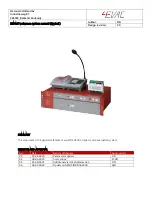
Operation Manual
ERO•SCAN
®
1
8106556 Rev. 11
4
13//08/2020
1 Introduction
This Section offers you important information about:
▪
the intended use of the device
▪
indications and contraindications of use
▪
features and benefits
▪
a description of the device
1.1 Intended Use Statement
The ERO•SCAN
®
Hearing Test System is indicated for testing of cochlear function in
infants, children, and adults by measuring otoacoustic emissions (OAEs). This
instrument is suitable for use in all settings, including hospitals, schools, physician's
offices, and audiologist practices. Factory defined protocols allow for simple screening
measurements and user customizable protocols allow for diagnostic evaluations. The
ERO•SCAN
®
is intended to be used by hearing healthcare professionals (i.e. ENT
doctors, audiologists) and/or technicians, neonatal nurses and school nurses who have
been trained by a hearing healthcare professional.
1.2 Indications for Use Statement
The OAEs are generated by a series of clicks that are directed into the ear canal.
Otoacoustic emissions are low level audio-frequency sounds that are produced by the
cochlea as part of the normal-hearing process. Available evidence suggests that
otoacoustic emissions are generated by the cochlea’s outer hair cells and that the
presence of OAEs is an indication that the outer hair cells are viable. Clinical evidence
indicates that these emissions normally occur with normal hearing, or at most, mild
hearing loss (usually 30-40 dB HL). The majority of hearing-impaired individuals will
be identified by a simple OAE test.
1.3 Contraindications of Use Statement
Testing should not be performed on patients with one of the following symptoms
without a medical doctor’s approval:
•
Recent stapedectomy or other middle ear surgery
•
Discharging ear
•
Acute external auditory canal trauma
•
Discomfort (e.g. severe otitis externa)
•
Occlusion of the external auditory canal
Visual inspection for obvious structural abnormalities of the external ear structure and
positioning as well as the external ear canal should be performed before testing.







































